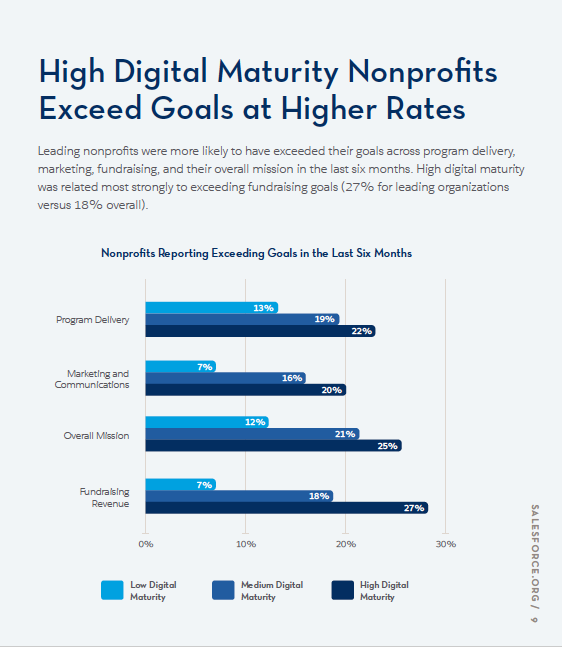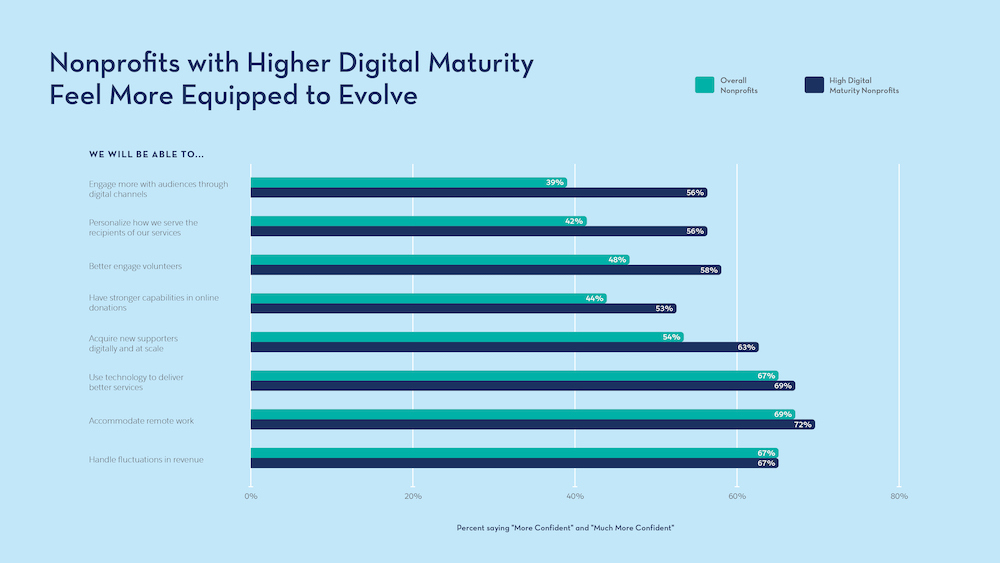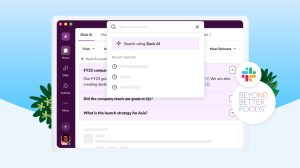Today, Salesforce.org published its third edition of its Nonprofit Trends Report. The report, which was done in collaboration with the Urban Institute, incorporates input from 867 nonprofit professionals from six countries across North America and Europe. Organizations surveyed varied in size from one employee to more than 250 employees, and covered a wide spectrum of cause areas and job roles.
The findings offer insights into just how much technology impacts an organization’s success metrics through the lens of digital maturity. Digital maturity, as defined in the report, is characterized by an organization’s ability to leverage data to inform decision-making, reach new audiences, personalize communications, and forecast fundraising income.
The goal of the survey, and subsequent report, was to better understand issues facing the sector — which has been particularly hard hit by the pandemic — in three strategic areas.
The first is digital experience, which covers the challenges and opportunities associated with an organization’s use of technology. The second is how successful an organization is at managing through change, characterized by its strategies and challenges related to the pandemic. Finally, the survey sought to understand how an organization was planning for the future, including both the concerns and optimism in the ability to achieve their missions in the coming months.
The comprehensive report includes insight that is particularly helpful to understand how organizations are managing through the COVID-19 pandemic, and what their outlook is for the future. Here are three of the biggest findings from the report.
The organizations with the most innovative and confident responses to the pandemic are the same ones that have a high digital maturity.
The pandemic has served as a spotlight for many issues since March, revealing countless areas where innovation, growth, and improvement is crucial. The Nonprofit Trends Report revealed a similar sentiment as it proved that the digital imperative is more than just a marketing buzzword.
Confidence in an organization’s response to the pandemic covered areas like marketing, fundraising, and strengthening supporter relationships. Leading nonprofits were better able to understand their environment, had fewer fears and more confidence in the future, and were better equipped to build meaningful relationships with donors and constituents.
Nearly half (48%) of high digital maturity nonprofits said they were “Likely” to gain support for their cause over the next six months, versus nearly one in five low digital maturity organizations.
Across the board, digital maturity was a strong indicator of success. Organizations that ranked high on the digital maturity scale were not only more likely to continue innovating, they were also more likely to effectively pivot their work during the pandemic. The high digital maturity marker also indicated how well organizations handled the crisis and how they adapted in the midst of change. Additionally, high digital maturity was a consistent factor among organizations that both won grant increases and avoided declines during an incredibly unpredictable year.
Organizations considered to be high digital maturity exceeded goals more consistently over the last six months.
Again, the report shows a distinct correlation between high digital maturity organizations and those that met or exceeded their goals. High digital maturity indicated a strong performance in four key areas: marketing and communications, fundraising, program delivery, and overall mission.
For high digital maturity organizations, 85% were more likely to have met or exceeded their fundraising goals, compared to 66% of low digital maturity nonprofits. Similarly, 71% of high digital maturity organizations said they met or exceeded their goals for program delivery, versus 56% of medium and 44% of low digital maturity ones.
Those that earned the high digital maturity marker fared between 3-9% better than organizations that landed in the medium digital maturity category. Unsurprisingly, high digital maturity organizations did significantly better compared to low digital maturity ones, scoring between 9-25% higher.

High digital maturity nonprofits reported higher confidence in the future and fewer fears about what’s to come.
If it wasn’t already clear, this report proved it: having the necessary technology is hugely important, especially during unpredictable periods of change. Thirty percent of high digital maturity (leading) nonprofits were much more confident that they will be better able to handle fluctuations in revenue, compared to 24% of nonprofits overall.
Nonprofits with a high digital maturity were also better equipped to understand their environment, reporting higher confidence in the future and fewer fears about what’s ahead. When asked to describe their level of optimism for the coming months, 38% of high digital maturity nonprofits said it was “Likely” that they could grow major giving in the next 6-12 months. Comparatively, that number was just 9% for low digital maturity nonprofits.
It shouldn’t be a surprise then, that when it came to things like communicating with their audience, personalizing their services, and engaging with volunteers, organizations that led in digital maturity were significantly more confident in their abilities.

Navigating change — especially the change that we’ve seen in 2020 — is hard enough on its own. The third edition of the Salesforce.org Nonprofit Trends Report proves how exponential that challenge becomes when organizations don’t have the digital tools necessary to be agile, efficiently reach supporters, or innovate for the future. The clear correlation between organizations with high digital maturity and those with the most positive outlook — both in the present and the future — illustrates the critical importance of the digital imperative for nonprofits.



















